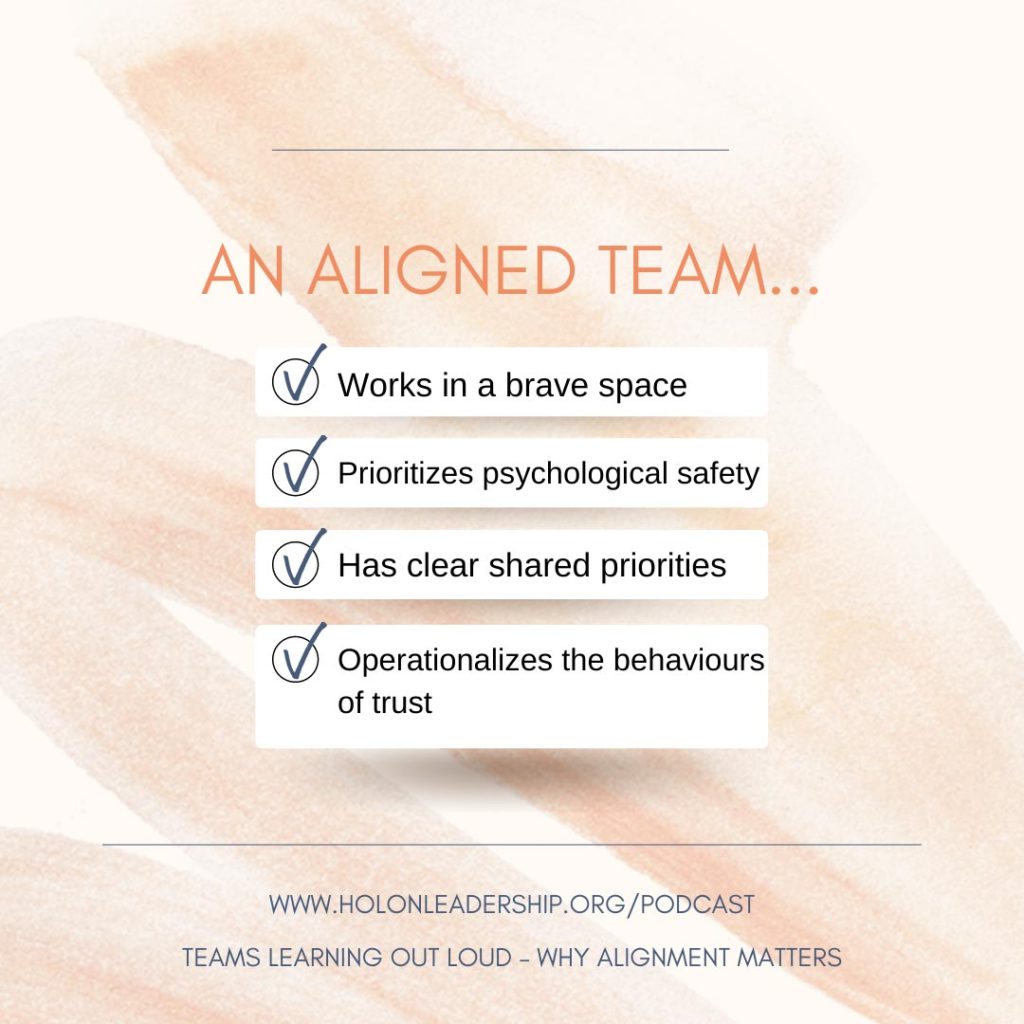Hi everyone, I’m Saralyn Hodgkin. And this is the podcast to practice your leadership.
Moving in the same direction, team alignment. Oh my gosh, do you know how often I talk about this? Align, alignment, team alignment? Oh, my goodness gracious. It’s an important conversation, you know, if for no other reason than for teams to be aligned, or to work towards alignment, so that they can meet their goals in a way where everybody can be human, right? But then the question that comes up a lot is What does that look like? What are the questions that come up? When we talk about team alignment, how does an align team act? What does that look like? Right? Like, what does that look like?
And with all my work with teams, and holding teams, and being in teams, sometimes we get caught up in just using the word. Oh, yeah, got to be aligned on that, versus centering in and grounding ourselves. What are our behaviors, our activities that foster and cultivate our alignment? Do you hear the intentionality in my voice there? That’s the key for me is that it’s not just a flippant word that’s used and thrown around. Yeah, we’ve got to do that, and it sounds important. Oh, yeah. Alignment? No. It is an intentional practice, for the inner workings of teams to cultivate alignment.
And don’t get me wrong, the curls that come out of this, the questions that come up or out that sort of say Ding, ding, ding, we gotta talk about team alignment. Some of the stuff that comes up is, hey, what is our team structure? Like, is it really working? How do we make decisions here? Is that your role? Is that my role? Okay, but in that role, are you responsible for this? Or am I responsible for this? How do we work together so we’re not tripping over each other, but I want to keep you informed? Like when you start to hear that in your teams, right? It’s like, cool. I think we’re talking about alignment here. Decision making, okay, do we bring in a RACI model? Or like, what do we do here? How do we decide who decides and when they decide? And what’s the code of that decision making?
Oh, my gosh, right? We’ve all been here and talked about this. Again, ding ding dings, we’re talking about team alignment. When we talk about, how do I manage my people, how do I, how do I help my direct reports or my other team members? In my leadership? How do I help them in their work? How do I help them in the ways that I’m managing or helping them manage their work? Oh, wow, I’m talking about alignment, alignment between us. Maybe I’m bringing in situational leadership, how I bring my leadership to holding you as a colleague in every situation you find yourself in. How can I show up for you to help empower you in doing the job that you need to do? There’s a whole framework behind this for another time.
Team alignment comes in many different forms in the conversation. And the big question is, what are the practices? How do we act as an aligned team? There’s three or four things here that are important in the how question. One of them is that when somebody asks me, how does an align team act, my first response is that it’s a brave space. How an align team acts is that there is bravery, psychological safety. Disruptors, hey, you’re welcome here. We should all actually have the role of disruptor at some point.
We have our shared communication prompts to, as Brene Brown talks about, rumble together, right? Our shared communication prompts that allow the invitation to pose hard questions, to come forth in our vulnerabilities by sharing this idea. Brave space. We’ve defined what it means for us to have a brave space. In these brave spaces, we hold the tension of accountability and empowerment in these brave spaces. Conflict is part of the package. It’s the grit in which we’re working in, it’s out in front of us. The conflict is not between us, the conflict is out in front of us.
In aligned teams we are asking hard conversations on what the barriers are to us making decisions. Having clarity of rules, having a clear structure. We’re also trying to surface what hard conversations are we avoiding in these aligned teams? We have clear shared priorities What that means is that as a team, we can see and communicate with each other easily our north star where we’re headed. Some might call it your BHAG over the next three years. Big, hairy, audacious goals. Thank you, Jim Collins, right?
As a team, if the first thing is brave space, this is the second thing, right, is that we understand our shared priorities. And we are all pointed in the same direction. If you imagine everything like an arrow on your team, the systems you use, the communication technology you use, the programming, the work. All of those as arrows are all pointed towards the north star and someone’s role is specifically focused on not just helping the plates and seeing the spinning plates, but helping those plates be arrows pointed the same direction.
That we understand the shared priorities and we understand what we’re not working on right now, even though we really want to, but no, we have a shared understanding of what we’re not working on. And we’re holding each other accountable in that, in that not working on list, in that no list. Oh, I know, it would be really great if we did a comms piece on that. But that’s part of our no list. Can we peel that off here? Shared priorities, shared priorities.
That when we are all pointed in the same direction, we can all clearly articulate why this team exists. Why do we exist as a team? Teams aren’t just created, because they’re fun. Teams are created in order to work together. Team work, work together as a team for some purpose, and we all understand and have a shared understanding of why we exist. And I personally know how my job fits into all of this, how the team fits into the organizational alignment. We’re all singing from the same song sheet.
And also, how an aligned team acts is that it’s operationalizing the behaviors of trust. When I get into a conversation of trust here, I think about Brene Brown’s The Anatomy of Trust, and it acts as a braving, acts as an anatomy to define the behaviors of trust. In teams, operationalize these behaviors of trust in a way that works for them, which means that you have a common definition of what trust looks like on this team, what our behaviors around trust looks like on this team, and so on, and so an aligned team acts in alignment to that definition of trust for our team. That our behaviors are aligned with that, that our accountability to one another, to ourselves is aligned with that.
So when I get asked, how does an align team act? You know, there’s lots of answers there. But the other part is, when I think with my gut brain and my heart brain, my answer is, you know. You know when there’s alignment, and you know when there’s not. And so what are the hard conversations that need to be had to say, I don’t think we’re in alignment here? And what are the conscious conversations that need to be had on your team that say, I think this is how we’re behaving in a way that’s constructing alignment? Can we be intentional about that? How does it feel to be aligned? What does it look like to be aligned? Why does it matter for our team to be aligned?
Being an aligned team is about behaviors, and actions, and conversations that help the team be innovative and creative and meet its goals. All while holding at the centre of those relationships that make the team because the relationships matter. You’ve got to be human while you’re getting the work done. So here again, the inner work of teams is about working on us as a team, journeying together with the work, and with us as the work.
Thanks all, I’m Saralyn. You can find me at holonleadership.org. I walk alongside you as you practice your leadership.



 Apple Podcasts
Apple Podcasts Spotify
Spotify Google Podcasts
Google Podcasts